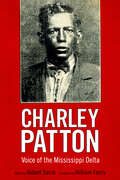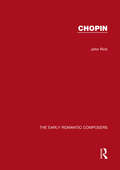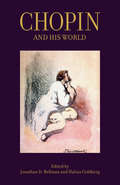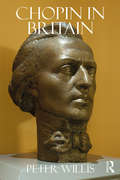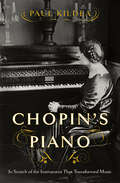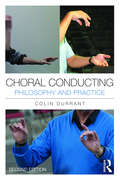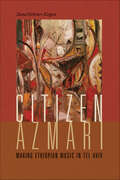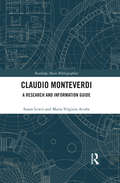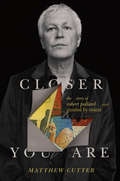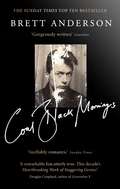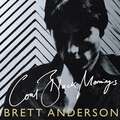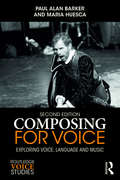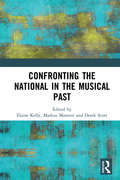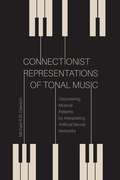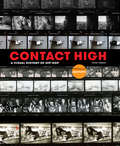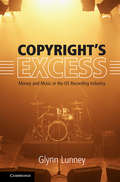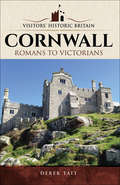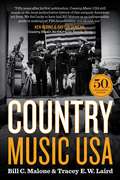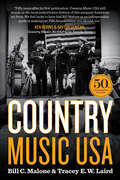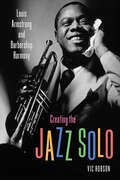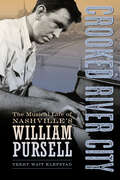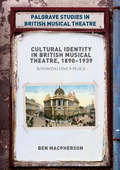- Table View
- List View
Charley Patton: Voice of the Mississippi Delta (American Made Music Series)
by Robert SacréBlues Book of the Year —26th Annual Living Blues Awards Contributions by Luther Allison, John Broven, Daniel Droixhe, David Evans, William Ferris, Jim O'Neal, Mike Rowe, Robert Sacré, Arnold Shaw, and Dick Shurman Fifty years after Charley Patton's death in 1934, a team of blues experts gathered five thousand miles from Dockery Farms at the University of Liege in Belgium to honor the life and music of the most influential artist of the Mississippi Delta blues. This volume brings together essays from that international symposium on Charley Patton and Mississippi blues traditions, influences, and comparisons. Originally published by Presses Universitaires de Liège in Belgium, this collection has been revised and updated with a new foreword by William Ferris, new images added, and some essays translated into English for the first time. Patton's personal life and his recorded music bear witness to how he endured and prevailed in his struggle as a black man during the early twentieth century. Within this volume, that story offers hope and wonder. Organized in two parts—“Origins and Traditions” and “Comparison with Other Regional Styles and Mutual Influence”—the essays create an invaluable resource on the life and music of this early master. Written by a distinguished group of scholars, these pieces secure the legacy of Charley Patton as the fountainhead of Mississippi Delta blues.
Chopin
by John RinkThis anthology brings together representative examples of the most significant and engaging scholarly writing on Chopin by a wide range of authors. The essays selected for the volume portray a rounded picture of Chopin as composer, pianist and teacher of his music, and of his overall achievement and legacy. Historical perspectives are offered on Chopin’s biography ’as cultural discourse’, on the evolution and origins of his style, and on the contexts of given works. A fascinating contemporary overview of Chopin’s oeuvre is also provided. Seven source studies assess the status and role of Chopin’s notational practices as well as some enigmatic sketch material. Essays in the field of performance studies scrutinise the ’cultural work’ carried out by Chopin’s performances and discuss his playing style along with that of his contemporaries and students. This paves the way for a body of essays on analysis, aesthetics and reception, considering aspects of genre and including an overview of analytical approaches to select works. The remaining essays address Chopin’s handling of form, rhythm and other musical elements, as well as the ’meaning’ of his msuic. The collection as a whole underscores one of the most important aspects of Chopin’s legacy, namely the paradoxical manner in which he drew from the past - in particular, certain eighteenth-century traditions - while stretching inherited conventions and practices to such an extent that a highly original ’music of the future’ was heralded.
Chopin and His World
by Jonathan D. Bellman Halina GoldbergA new look at the life, times, and music of Polish composer and piano virtuoso Fryderyk ChopinFryderyk Chopin (1810–49), although the most beloved of piano composers, remains a contradictory figure, an artist of virtually universal appeal who preferred the company of only a few sympathetic friends and listeners. Chopin and His World reexamines Chopin and his music in light of the cultural narratives formed during his lifetime. These include the romanticism of the ailing spirit, tragically singing its death-song as life ebbs; the Polish expatriate, helpless witness to the martyrdom of his beloved homeland, exiled among friendly but uncomprehending strangers; the sorcerer-bard of dream, memory, and Gothic terror; and the pianist's pianist, shunning the appreciative crowds yet composing and improvising idealized operas, scenes, dances, and narratives in the shadow of virtuoso-idol Franz Liszt. The international Chopin scholars gathered here demonstrate the ways in which Chopin responded to and was understood to exemplify these narratives, as an artist of his own time and one who transcended it. This collection also offers recently rediscovered artistic representations of his hands (with analysis), and—for the first time in English—an extended tribute to Chopin published in Poland upon his death and contemporary Polish writings contextualizing Chopin's compositional strategies. The contributors are Jonathan D. Bellman, Leon Botstein, Jean-Jacques Eigeldinger, Halina Goldberg, Jeffrey Kallberg, David Kasunic, Anatole Leikin, Eric McKee, James Parakilas, John Rink, and Sandra P. Rosenblum. Contemporary documents by Karol Kurpiński, Adam Mickiewicz, and Józef Sikorski are included.
Chopin in Britain
by Peter WillisIn 1848, the penultimate year of his life, Chopin visited England and Scotland at the instigation of his aristocratic Scots pupil, Jane Stirling. In the autumn of that year, he returned to Paris. The following autumn he was dead. Despite the fascination the composer continues to hold for scholars, this brief but important period, and his previous visit to London in 1837, remain little known. In this richly illustrated study, Peter Willis draws on extensive original documentary evidence, as well as cultural artefacts, to tell the story of these two visits and to place them into aristocratic and artistic life in mid-nineteenth-century England and Scotland. In addition to filling a significant hole in our knowledge of the composer’s life, the book adds to our understanding of a number of important figures, including Jane Stirling and the painter Ary Scheffer. The social and artistic milieux of London, Manchester, Glasgow and Edinburgh are brought to vivid life.
Chopin's Piano: In Search Of The Instrument That Transformed Music
by Paul KildeaThe captivating story of Frédéric Chopin and the fate of both his Mallorquin piano and musical Romanticism from the early nineteenth to the mid-twentieth century. In November 1838, Frédéric Chopin, George Sand, and her two children sailed to Majorca to escape the Parisian winter. They settled in an abandoned monastery at Valldemossa in the mountains above Palma where Chopin finished what would eventually be recognized as one of the great and revolutionary works of musical Romanticism: his twenty-four Preludes. There was scarcely a decent piano on the island (these were still early days in the evolution of the modern instrument), so Chopin worked on a small pianino made by a local craftsman, Juan Bauza, which remained in their monastic cell for seventy years after he and Sand had left. Chopin’s Piano traces the history of Chopin’s twenty-four Preludes through the instruments on which they were played, the pianists who interpreted them, and the traditions they came to represent. Yet it begins and ends with the Majorcan pianino, which assumed an astonishing cultural potency during the Second World War as it became, for the Nazis, a symbol of the man and music they were determined to appropriate as their own. After Chopin, the unexpected hero of Chopin’s Piano is the great keyboard player Wanda Landowska, who rescued the pianino from Valldemossa in 1913, and who would later become one of the most influential artistic figures of the twentieth century. Paul Kildea shows how her story—a compelling account based for the first time on her private papers—resonates with Chopin’s, simultaneously distilling part of the cultural and political history of mid-twentieth century Europe and the United States. After Landowska’s flight to America from Paris, which the Germans would occupy only days later, her possessions—including her rare music manuscripts and beloved keyboards—were seized by the Nazis. Only some of these belongings survived the war; those that did were recovered by the Allied armies’ Monuments Men and restituted to Landowska’s house in France. In scintillating prose, and with an eye for exquisite detail, Kildea beautifully interweaves these narratives, which comprise a journey through musical Romanticism—one that illuminates how art is transmitted, interpreted, and appropriated between generations.
Choral Conducting: Philosophy and Practice
by Colin DurrantChoral Conducting: Philosophy and Practice, Second Edition is an updated resource for conductors and singers alike, a college-level text for students of choral conducting that considers conducting and singing from a holistic perspective. This singer-friendly and voice-healthy approach examines the rehearsal environment alongside its musical performance counterpart. The author explores what is involved in leading a choral group, examining theories of learning and human behavior to understand the impact choral conductors have on the act of singing. Divided into two main parts—Philosophy and Practice—the text begins with an historical look at conducting, exploring questions of why people sing and why they sing together, and ultimately presents the application of this philosophy, showing how a conductor’s gestures and patterns can influence vocal outcomes. In addressing how singers learn and respond to choral music, as well as how conductors communicate with singers in rehearsal and performance, Choral Conducting turns an eye to learning how we learn and the role successful choral conductors play in motivating singers, developing healthy singing habits, and improving individual and ensemble vocal quality—all with the aims of enhancing musical understanding. New to this edition: Updated diagrams, photos, and musical examples Revised sample choral programs Increased consideration of the orchestral conductor A renewed focus on the intersections of learning, health and well-being, and the social perspective, supported by new and recent research
Citizen Azmari: Making Ethiopian Music in Tel Aviv (Music/culture Ser.)
by Ilana Webster-Kogen2019 Winner of Society of Ethnomusicology's Special Interest Group Award for Jewish MusicIn the thirty years since their immigration from Ethiopia to the State of Israel, Ethiopian-Israelis have put music at the center of communal and public life, using it alternatingly as a mechanism of protest and as appeal for integration. Ethiopian music develops in quiet corners of urban Israel as the most prominent advocate for equality, and the Israeli-born generation is creating new musical styles that negotiate the terms of blackness outside of Africa. For the first time, this book examines in detail those new genres of Ethiopian-Israeli music, including Ethiopian-Israeli hip-hop, Ethio-soul performed across Europe, and eskesta dance projects at the center of national festivals. This book argues that in a climate where Ethiopian-Israelis fight for recognition of their contribution to society, musical style often takes the place of political speech, and musicians take on outsize roles as cultural critics. From their perch in Tel Aviv, Ethiopian-Israeli musicians use musical style to critique a social hierarchy that affects life for everyone in Israel/Palestine.
Claudio Monteverdi: A Research and Information Guide (Routledge Music Bibliographies)
by Susan Lewis Maria Virginia AcuñaClaudio Monteverdi: A Research and Information Guide is an annotated bibliography that navigates the vast scholarly resources on the composer with the most updated compilation since 1989. Claudio Monteverdi transformed and mastered the principal genres of his day and his works influenced generations of musicians and other artists. He initiated one of the most important aesthetic debates of the era by proposing a new relationship between poetry and harmony. In addition to scholarship by musicologists and music theorists, Monteverdi’s music has attracted attention from literary scholars, cultural historians, and critical theorists. Research into Monteverdi and Renaissance and early baroque studies has expanded greatly, with the field becoming more complex as scholars address such issues as gender theory, feminist criticism, cultural theory, new criticism, new historicism, and artistic and popular cultures. The guide serves both as a foundational starting point and as a gateway for future inquiry in such fields as court culture, opera, patronage, and Italian poetry.
Closer You Are: The Story of Robert Pollard and Guided By Voices
by Matthew CutterThe authorized biography of Robert Pollard, indie rock icon and founder of the music group Guided By VoicesRobert Pollard has been a staple of the indie rock scene since the early '80s, along with his band Guided By Voices. Pollard was a longtime grade school teacher who toiled endlessly on his music, finding success only after adopting a do-it-yourself approach, relying on lo-fi home recordings for much of his and his band's career. A prolific artist, Pollard continues to churn out album after album, much to the acclaim of critics and his obsessive and devoted fans. But his story has never been faithfully told in its entirety. Until now.Author Matthew Cutter is a longtime friend of Pollard and, with Pollard's blessing, he's set out to tell the whole, true story of Guided By Voices. Closer You Are is the first book to take an in-depth look at the man behind it all, with interviews conducted by the author with Pollard's friends, family, and bandmates, along with unfettered access to Pollard himself and his extensive archives.Robert Pollard has had an amazing and seemingly endless career in rock music, but he's also established himself as a consummate artist who works on his own terms. Now fans can at long last learn the full story behind one of America's greatest living songwriters.
Coal Black Mornings
by Brett AndersonEvening Standard Book of the Year. Observer Book of the Year. Guardian Book of the Year. Sunday Times Book of the Year. Telegraph Book of the Year. New Statesman Book of the Year. Herald Book of the Year. Mojo Book of the Year.Brett Anderson came from a world impossibly distant from rock star success, and in Coal Black Mornings he traces the journey that took him from a childhood as 'a snotty, sniffy, slightly maudlin sort of boy raised on Salad Cream and milky tea and cheap meat' to becoming founder and lead singer of Suede.Anderson grew up in Hayward's Heath on the grubby fringes of the Home Counties. As a teenager he clashed with his eccentric taxi-driving father (who would parade around their council house dressed as Lawrence of Arabia, air-conducting his favourite composers) and adored his beautiful, artistic mother. He brilliantly evokes the seventies, the suffocating discomfort of a very English kind of poverty and the burning need for escape that it breeds. Anderson charts the shabby romance of creativity as he travelled the tube in search of inspiration, fuelled by Marmite and nicotine, and Suede's rise from rehearsals in bedrooms, squats and pubs. And he catalogues the intense relationships that make and break bands as well as the devastating loss of his mother.Coal Black Mornings is profoundly moving, funny and intense - a book which stands alongside the most emotionally truthful of personal stories.
Coal Black Mornings
by Brett AndersonBrett Anderson came from a world impossibly distant from rock star success, and in Coal Black Mornings he traces the journey that took him from a childhood as 'a snotty, sniffy, slightly maudlin sort of boy raised on Salad Cream and milky tea and cheap meat' to becoming founder and lead singer of Suede.Anderson grew up in Hayward's Heath on the grubby fringes of the Home Counties. As a teenager he clashed with his eccentric taxi-driving father (who would parade around their council house dressed as Lawrence of Arabia, air-conducting his favourite composers) and adored his beautiful, artistic mother. He brilliantly evokes the seventies, the suffocating discomfort of a very English kind of poverty and the burning need for escape that it breeds. Anderson charts the shabby romance of creativity as he travelled the tube in search of inspiration, fuelled by Marmite and nicotine, and Suede's rise from rehearsals in bedrooms, squats and pubs. And he catalogues the intense relationships that make and break bands as well as the devastating loss of his mother.Coal Black Mornings is profoundly moving, funny and intense - a book which stands alongside the most emotionally truthful of personal stories.
Coal Black Mornings
by Brett AndersonListen to the end for an audiobook exclusive: Brett Anderson in conversation with Matt Thorne, author of Prince. Brett Anderson came from a world impossibly distant from rock star success, and in Coal Black Mornings he traces the journey that took him from a childhood as 'a snotty, sniffy, slightly maudlin sort of boy raised on Salad Cream and milky tea and cheap meat' to becoming founder and lead singer of Suede.Anderson grew up in Hayward's Heath on the grubby fringes of the Home Counties. As a teenager he clashed with his eccentric taxi-driving father (who would parade around their council house dressed as Lawrence of Arabia, air-conducting his favourite composers) and adored his beautiful, artistic mother. He brilliantly evokes the seventies, the suffocating discomfort of a very English kind of poverty and the burning need for escape that it breeds. Anderson charts the shabby romance of creativity as he travelled the tube in search of inspiration, fuelled by Marmite and nicotine, and Suede's rise from rehearsals in bedrooms, squats and pubs. And he catalogues the intense relationships that make and break bands as well as the devastating loss of his mother.Coal Black Mornings is profoundly moving, funny and intense - a book which stands alongside the most emotionally truthful of personal stories.
Community Custodians of Popular Music's Past: A DIY Approach to Heritage (Routledge Research in Music)
by Sarah BakerThis book examines do-it-yourself (DIY) approaches to the collection, preservation, and display of popular music heritage being undertaken by volunteers in community archives, museums and halls of fame globally. DIY institutions of popular music heritage are much more than ‘unofficial’ versions of ‘official’ institutions; rather, they invoke a complex network of affect and sociality, and are sites where interested people – often enthusiasts – are able to assemble around shared goals related to the preservation of and ownership over the material histories of popular music culture. Drawing on interviews and observations with founders, volunteers and heritage workers in 23 DIY institutions in Australasia, Europe and North America, the book highlights the potentialities of bottom-up, community-based interventions into the archiving and preservation of popular music’s material history. It reveals the kinds of collections being housed in these archives, how they are managed and maintained, and explores their relationship to mainstream heritage institutions. The study also considers the cultural labor of volunteers in the DIY institution, arguing that while these are places concerned with heritage management and the preservation of artefacts, they are also extensions of musical communities in the present in which activities around popular music preservation have personal, cultural, community and heritage benefits. By looking at volunteers’ everyday interventions in the archiving and curating of popular music’s material past, the book highlights how DIY institutions build upon national heritage strategies at the community level and have the capacity to contribute to the democratization of popular music heritage. This book will have a broad appeal to a range of scholars in the fields of popular music studies, musicology, ethnomusicology, archive studies and archival science, museum studies, critical heritage studies, cultural studies, cultural sociology and media studies.
Composing for Voice: Exploring Voice, Language and Music (Routledge Voice Studies)
by Paul Barker Maria HuescaComposing for Voice: Exploring Voice, Language and Music, Second Edition, elucidates how language and music function together from the perspectives of composers, singers and actors, providing an understanding of the complex functions of the voice pedagogically, musicologically and dramatically. Composing for Voice examines the voice across a wide range of musical genres (including pop, jazz, folk, classical, opera and the musical) and explores the fusion of language and music that is unique to song. This second edition is enlarged to attract a wider readership amongst all music and theatre professionals and educators, whilst also engaging an international audience with the introduction of new co-author Maria Huesca. New to the second edition: A review of the history of singing An overview of the development of melisma A chapter to help performers understand each other, as singers and actors often receive disparate educations Case studies and qualitative research around song, lyric and meaning A discussion of the synthetic voice An introduction to the concept of embodied composition Interviews with composers and singers Summaries of various vocal styles A website with links to performances discussed, as well as related workshops: www.composingforvoice.com Composing for Voice: Exploring Voice, Language and Music, Second Edition, articulates possibilities for the practical exploration of language, music and voice by composers, singers and actors.
Confronting the National in the Musical Past
by Elaine Kelly Markus Mantere Derek B. ScottThis significant volume moves music-historical research in the direction of deconstructing the national grand narratives in music history, of challenging the national paradigm in methodology, and thinking anew about cultural traffic, cultural transfer and cosmopolitanism in the musical past. The chapters of this book confront, or subject to some kind of critique, assumptions about the importance of the national in the musical past. The emphasis, therefore, is not so much on how national culture has been constructed, or how national cultural institutions have influenced musical production, but, rather, on the way the national has been challenged by musical practices or audience reception.
Connectionist Representations of Tonal Music: Discovering Musical Patterns by Interpreting Artifical Neural Networks
by Michael R. DawsonPreviously, artificial neural networks have been used to capture only the informal properties of music. However, cognitive scientist Michael Dawson found that by training artificial neural networks to make basic judgments concerning tonal music, such as identifying the tonic of a scale or the quality of a musical chord, the networks revealed formal musical properties that differ dramatically from those typically presented in music theory. For example, where Western music theory identifies twelve distinct notes or pitch-classes, trained artificial neural networks treat notes as if they belong to only three or four pitch-classes, a wildly different interpretation of the components of tonal music. Intended to introduce readers to the use of artificial neural networks in the study of music, this volume contains numerous case studies and research findings that address problems related to identifying scales, keys, classifying musical chords, and learning jazz chord progressions. A detailed analysis of the internal structure of trained networks could yield important contributions to the field of music cognition.
Contact High: A Visual History of Hip-Hop
by Questlove Vikki TobakAn inside look at the work of hip-hop photographers told through their most intimate diaries—their contact sheets. Featuring rare outtakes from over 100 photoshoots alongside interviews and essays from industry legends, Contact High: A Visual History of Hip-Hop takes readers on a chronological journey from old-school to alternative hip-hop and from analog to digital photography. The ultimate companion for music and photography enthusiasts, Contact High is the definitive history of hip-hop’s early days, celebrating the artists that shaped the iconic album covers, t-shirts and posters beloved by hip-hop fans today. With essays from BILL ADLER, RHEA L. COMBS, FAB 5 FREDDY, MICHAEL GONZALES, YOUNG GURU, DJ PREMIER, and RZA
Copyright’s Excess: Money and Music in the U. S. Recording Industry
by Glynn LunneyFor more than 200 years, copyright in the United States has rested on a simple premise: more copyright will lead to more money for copyright owners, and more money will lead to more original works of authorship. In this important, illuminating book, Glynn Lunney tests that premise by tracking the rise and fall of the sound recording copyright from 1961 to 2015, along with the associated rise and fall in sales of recorded music. Far from supporting copyright’s fundamental premise, the empirical evidence finds the exact opposite relationship: more revenue led to fewer and lower-quality hit songs. Lunney’s breakthrough research shows that what copyright does is vastly increase the earnings of our most popular artists and songs Doing so reduced their productivity. At the same time, copyright did very little to increase the earnings of, and hence increase the productivity of, artists at the margins. The net result: more revenue was associated with the release of fewer hit songs. This book should be read by anyone interested in how copyright operates in the real world.
Cornwall: Romans to Victorians (Visitors' Historic Britain)
by Derek TaitCornwall has a rich and diverse history stretching from prehistoric times to the Norman Conquest and beyond, including the turbulent Tudor period, the English Civil War and the First and Second World Wars. Neolithic settlements and Bronze Age dwellings have been found at Carn Brea in Redruth and Rough Tour at Camelford, and many standing stones are scattered across the land. An ancient forest lies beneath the waters between Marazion and the legendary St Michael's Mount, which dates back thousands of years.The area is steeped in legend and Tintagel has mythical connections with King Arthur, although the present castle was probably constructed by Richard, Earl of Cornwall (brother to King Henry III), who owned the site from about 1234. Tales of the Devil, giants, minions and other imps abound in the county.Many of Daphne Du Maurier's books are set in Cornwall including Jamaica Inn and Frenchman's Creek. Virginia Woolf's novel To the Lighthouse was based on holidays at St Ives, Cornwall, where her family took her every summer until 1895. The lighthouse at Godrevy gives inspiration to the title.Various battles and conflicts as well as the diverse and fascinating history of Cornwall are all featured within the pages of this book, which also includes many of the well-known people who have greatly influenced the area over the years.
Country Music USA
by Bill C. Malone Tracey E. W. Laird“Fifty years after its first publication, Country Music USA still stands as the most authoritative history of this uniquely American art form. Here are the stories of the people who made country music into such an integral part of our nation’s culture. We feel lucky to have had Bill Malone as an indispensable guide in making our PBS documentary; you should, too.” —Ken Burns and Dayton Duncan, Country Music: An American Family Story From reviews of previous editions: “Considered the definitive history of American country music.” —Los Angeles Times “If anyone knows more about the subject than [Malone] does, God help them.” —Larry McMurtry, from In a Narrow Grave “With Country Music USA, Bill Malone wrote the Bible for country music history and scholarship. This groundbreaking work, now updated, is the definitive chronicle of the sweeping drama of the country music experience.” —Chet Flippo, former editorial director, CMT: Country Music Television and CMT.com “Country Music USA is the definitive history of country music and of the artists who shaped its fascinating worlds.” —William Ferris, University of North Carolina at Chapel Hill, former chairman of the National Endowment for the Humanities and coeditor of the Encyclopedia of Southern Culture Since its first publication in 1968, Bill C. Malone’s Country Music USA has won universal acclaim as the definitive history of American country music. Starting with the music’s folk roots in the rural South, it traces country music from the early days of radio into the twenty-first century. In this fiftieth-anniversary edition, Malone, the featured historian in Ken Burns’s 2019 documentary on country music, has revised every chapter to offer new information and fresh insights. Coauthor Tracey Laird tracks developments in country music in the new millennium, exploring the relationship between the current music scene and the traditions from which it emerged.
Country Music USA: 50th Anniversary Edition
by Bill C. Malone Tracy E. Laird&“Still stands as the most authoritative history of this uniquely American art form . . . Bill Malone [was] an indispensable guide in making our PBS documentary.&” —Ken Burns and Dayton Duncan, Country Music: An American Family Story This is the newly updated edition of Country Music USA, &“considered the definitive history of American country music&” (Los Angeles Times). Starting with the music&’s folk roots in the rural South, it traces country music from the early days of radio into the twenty-first century. In this fiftieth-anniversary edition, Bill C. Malone, the featured historian in Ken Burns&’s 2019 documentary on country music, has revised every chapter to offer new information and fresh insights. Coauthor Tracey Laird tracks developments in country music in the new millennium, exploring the relationship between the current music scene and the traditions from which it emerged.Praise for Country Music USA: &“The country-music history bible.&” ―Rolling Stone &“This groundbreaking work, now updated, is the definitive chronicle of the sweeping drama of the country music experience.&” —Chet Flippo, former editorial director, CMT: Country Music Television and CMT.com &“The definitive history of country music and of the artists who shaped its fascinating worlds.&” —William Ferris, University of North Carolina at Chapel Hill, former chairman, National Endowment for the Humanities and coeditor, Encyclopedia of Southern Culture &“If anyone knows more about the subject than [Malone] does, God help them.&” —Larry McMurtry, from In a Narrow Grave: Essays on Texas
Country Music USA: 50th Anniversary Edition
by Bill C. Malone Tracy E. Laird&“Still stands as the most authoritative history of this uniquely American art form . . . Bill Malone [was] an indispensable guide in making our PBS documentary.&” —Ken Burns and Dayton Duncan, Country Music: An American Family Story This is the newly updated edition of Country Music USA, &“considered the definitive history of American country music&” (Los Angeles Times). Starting with the music&’s folk roots in the rural South, it traces country music from the early days of radio into the twenty-first century. In this fiftieth-anniversary edition, Bill C. Malone, the featured historian in Ken Burns&’s 2019 documentary on country music, has revised every chapter to offer new information and fresh insights. Coauthor Tracey Laird tracks developments in country music in the new millennium, exploring the relationship between the current music scene and the traditions from which it emerged.Praise for Country Music USA: &“The country-music history bible.&” ―Rolling Stone &“This groundbreaking work, now updated, is the definitive chronicle of the sweeping drama of the country music experience.&” —Chet Flippo, former editorial director, CMT: Country Music Television and CMT.com &“The definitive history of country music and of the artists who shaped its fascinating worlds.&” —William Ferris, University of North Carolina at Chapel Hill, former chairman, National Endowment for the Humanities and coeditor, Encyclopedia of Southern Culture &“If anyone knows more about the subject than [Malone] does, God help them.&” —Larry McMurtry, from In a Narrow Grave: Essays on Texas
Creating the Jazz Solo: Louis Armstrong and Barbershop Harmony (American Made Music Series)
by Vic HobsonThroughout his life, Louis Armstrong tried to explain how singing with a barbershop quartet on the streets of New Orleans was foundational to his musicianship. Until now, there has been no in-depth inquiry into what he meant when he said, “I figure singing and playing is the same,” or, “Singing was more into my blood than the trumpet.” Creating the Jazz Solo: Louis Armstrong and Barbershop Harmony shows that Armstrong understood exactly the relationship between what he sang and what he played, and that he meant these comments to be taken literally: he was singing through his horn.To describe the relationship between what Armstrong sang and played, author Vic Hobson discusses elements of music theory with a style accessible even to readers with little or no musical background. Jazz is a music that is often performed by people with limited formal musical education. Armstrong did not analyze what he played in theoretical terms. Instead, he thought about it in terms of the voices in a barbershop quartet.Understanding how Armstrong, and other pioneer jazz musicians of his generation, learned to play jazz and how he used his background of singing in a quartet to develop the jazz solo has fundamental implications for the teaching of jazz history and performance today. This assertive book provides an approachable foundation for current musicians to unlock the magic and understand jazz the Louis Armstrong way.
Crooked River City: The Musical Life of Nashville's William Pursell (American Made Music Series)
by Terry Wait KlefstadA pianist, arranger, and composer, William Pursell is a mainstay of the Nashville music scene. He has played jazz in Nashville’s Printer’s Alley with Chet Atkins and Harold Bradley, recorded with Johnny Cash and Patsy Cline, performed with the Nashville Symphony, and composed and arranged popular and classical music.Pursell’s career, winding like a crooked river between classical and popular genres, encompasses a striking diversity of musical experiences. A series of key choices sent him down different paths, whether it was reenrolling with the Air Force for a second tour of duty, leaving the prestigious Eastman School of Music to tour with an R&B band, or refusing to sign with the Beatles’ agent Sid Bernstein. The story of his life as a working musician is unlike any other—he is not a country musician nor a popular musician nor a classical musician but, instead, an artist who refused to be limited by traditional categories.Crooked River City is driven by a series of recollections and personal anecdotes Terry Wait Klefstad assembled over a three-year period of interviews with Pursell. His story is one not only of talent, but of dedication and hard work, and of the ins and outs of a working musician in America. This biography fills a crucial gap in Nashville music history for both scholars and music fans.
Cultural Identity in British Musical Theatre, 1890–1939: Knowing One's Place (Palgrave Studies In British Musical Theatre Ser.)
by Ben MacphersonThis book examines the performance of ‘Britishness’ on the musical stage. Covering a tumultuous period in British history, it offers a fresh look at the vitality and centrality of the musical stage, as a global phenomenon in late-Victorian popular culture and beyond. Through a re-examination of over fifty archival play-scripts, the book comprises seven interconnected stories told in two parts. Part One focuses on domestic and personal identities of ‘Britishness’, and how implicit anxieties and contradictions of nationhood, class and gender were staged as part of the popular cultural condition. Broadening in scope, Part Two offers a revisionary reading of Empire and Otherness on the musical stage, and concludes with a consideration of the Great War and the interwar period, as musical theatre performed a nostalgia for a particular kind of ‘Britishness’, reflecting the anxieties of a nation in decline.
